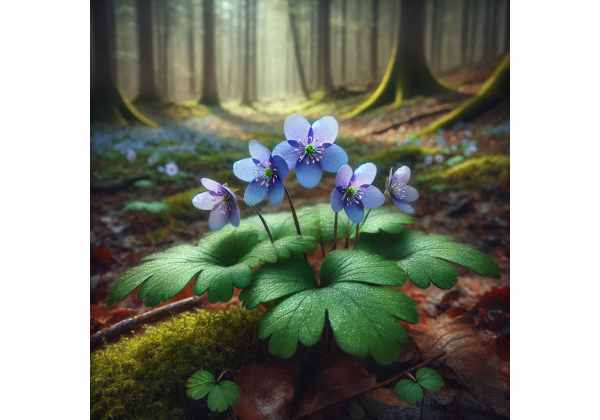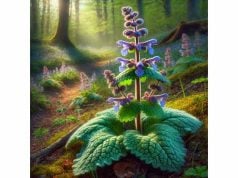
Liverworts are small, non-vascular plants that thrive in moist, shaded areas such as forest floors, stream banks, and damp rock faces. Known scientifically as bryophytes, they are among the earliest land plants and have drawn interest for potential health benefits spanning mild antimicrobial support, wound care, and more. Historically, they gained their name from their resemblance to a liver’s shape, sparking folkloric associations with hepatic wellness. Researchers have uncovered various compounds within certain liverwort species, such as aromatic terpenoids, that might contribute to subtle anti-inflammatory or antimicrobial effects. This comprehensive guide explores their botanical traits, chemical constituents, traditional advantages, usage tips, and modern research findings.
Table of Contents
- Comprehensive Botanical Overview
- Chemical Ingredients and Unique Components
- Health Advantages and Inherent Qualities
- Practical Applications and Necessary Precautions
- Key Research and Important Findings
- Common Questions with Brief Responses
Comprehensive Botanical Overview
Liverworts stand out as primitive plants, lacking the true roots, stems, and leaves found in higher plant families. Instead, they have flattened, ribbon-like “thalli” or leafy segments that adhere closely to damp surfaces. This group belongs to the phylum Marchantiophyta (or Hepatophyta, in older classifications), encompassing over 9,000 recognized species worldwide. Their diminutive size can make them easy to overlook, yet they play important roles in ecosystems—stabilizing soils, cycling nutrients, and offering microhabitats for small invertebrates.
Taxonomy and Classification
- Kingdom: Plantae
- Phylum (Division): Marchantiophyta
- Common Groups: Thalloid liverworts (with flattened, lobed structures) and leafy liverworts (with leaf-like segments arranged along stems).
Morphological Characteristics
- Thalli or Leafy Structures:
- Thalloid Types: Show flattened, green lobes or plate-like expansions hugging the substrate.
- Leafy Types: Develop small, overlapping “leaves” along slender stems. These “leaves” lack veins and are only a few cells thick.
- Reproductive Organs:
- Asexual Propagation: Via gemma cups or specialized brood bodies that detach and grow independently.
- Sexual Reproduction: Involves archegonia (female) and antheridia (male) structures, often on separate plants or specialized lobes.
- Rhizoids:
- Thin hair-like filaments that anchor the liverwort to surfaces rather than extracting significant nutrients from soil.
- Provide structural stability on moist logs, stones, or soil patches.
- Color and Texture:
- Typically green, but can appear brownish or translucent depending on moisture levels.
- Thalloid species sometimes exhibit patterns or ridges on their surfaces.
Habitat and Distribution
- Preferred Environments: Damp forests, stream banks, waterfalls, bogs, or shady rocks. Some species also colonize trees (epiphytes) or even live in ephemeral puddles.
- Global Presence: Liverworts occur from tropical rainforests to the polar regions, adapting to a wide range of humidity and temperature conditions, though they favor consistent moisture.
- Ecological Role: They help break down decaying materials, contribute to humus formation, and keep surfaces stable. Their presence indicates healthy microclimates with sufficient humidity.
Cultural and Historical Notes
Historically, due to the “Doctrine of Signatures,” it was assumed the liver-like shape of certain thalloid liverworts implied a beneficial effect on liver health. Thus, “liverwort” was occasionally integrated into older European herbal lore for hepatic or gallbladder concerns. Indigenous cultures worldwide have also recognized some species for minor uses, from wound coverings to mild analgesic or antiseptic applications.
Garden and Lab Cultivation
While not commonly grown for ornamental purposes, some specialized horticulturalists maintain humidity-controlled terrariums or “moss gardens” featuring liverworts for their unique, ancient charm. Research labs also culture them to study plant evolution, gene expression, and specialized secondary metabolites.
Bridging the gap between natural wonder and potential remedy, the next section delves into the chemical makeup that fosters interest in liverwort for mild health and wellness roles.
Chemical Ingredients and Unique Components
Unlike most vascular herbs, liverworts produce certain characteristic compounds that have intrigued biochemists. While they lack the robust vascular systems of flowering plants, they’ve evolved distinctive strategies for survival—including synthesizing specialized terpenoids, aromatic compounds, and small organic molecules. Here’s a closer look at those key substances.
- Sesquiterpenoids
- Definition: Complex molecules built from isoprene units.
- Relevance: Some liverwort genera (e.g., Marchantia, Porella, Frullania) feature an assortment of sesquiterpenes believed to combat microbes or deter herbivory. Laboratory tests suggest they may display anti-inflammatory or antifungal activities.
- Bibenzylic and Bibenzyl Derivatives
- Overview: Substances that might act as protective agents against pathogens or grazing invertebrates.
- Examples: Lunularic acid in certain liverworts. This compound may exhibit mild physiological effects relevant to human or animal systems, although extensive research is still developing.
- Aromatic Oils
- Characteristics: Certain species emit a distinct, sometimes peppery or spicy fragrance upon crushing.
- Possible Action: These volatile aromatic oils can display antibacterial, antifungal, or insect-repellent properties. They also contribute to the pungent odor that might have some utility in pest deterrence.
- Flavonoids and Phenolic Acids
- Purpose: Common in many plant taxa, these antioxidants help scavenge free radicals and limit oxidative stress.
- Potential Role: Could support mild anti-inflammatory or protective effects, though concentrations in liverworts vary.
- Tannins
- Nature: Polyphenolic compounds providing astringent qualities.
- Possible Benefit: Minor wound-cleansing or protective effect on irritated tissues when used externally, again subject to verification in specific species.
- Fatty Acid Derivatives
- Presence: Some species produce unique fatty acid or lipid-based molecules that help regulate water loss in ephemeral microhabitats.
- Implication: Not widely studied for medicinal significance, but might play a small role in the plant’s minimal moisture environment adaptation.
- Polysaccharides
- Function: Offer structural support or water retention.
- Human Application: Polysaccharides are sometimes linked to immunomodulatory or prebiotic-like effects in other plants, but these properties in liverwort remain underexplored.
Species-Specific Variations
Chemical composition can differ widely among liverwort species:
- Marchantia polymorpha: Known for producing distinctive sesquiterpenes and aromatic compounds.
- Conocephalum conicum: Often recognized by its strong, “camphor-like” odor, possibly from specialized oils.
- Frullania tamarisci: Linked to pungent essential oils used in certain folk traditions.
Environmental Influences
Factors influencing the presence or concentration of these active ingredients include:
- Moisture Levels: Drier conditions can stimulate the production of protective compounds.
- Light Intensity: Some phenolics or terpenoids might increase under higher UV exposure.
- Temperature Swings: Seasonal changes can affect chemical synthesis or storage.
These specialized metabolites support liverworts in their ecological niches. For humans, they open a window into potential uses that revolve around mild antiseptic, anti-inflammatory, or protective qualities. Let’s explore how these constituents translate into possible health benefits and inherent properties next.
Health Advantages and Inherent Qualities
Although rarely considered mainstream medicinal plants, certain liverworts have garnered interest from herbalists and natural product researchers for a handful of potential perks. Here, we delve into the attributes often cited in anecdotal records and emergent scientific explorations.
Mild Anti-Inflammatory Action
- Foundational Insight: Terpenoids and certain phenolic elements in liverworts could help modulate inflammatory pathways.
- Practical Examples: Some folk healers have used crushed liverwort thalli as a poultice on minor scrapes or inflamed skin patches. While not widely validated, the local population’s experiences occasionally mention gentle soothing benefits.
Antimicrobial Potential
- Protective Mechanism: The same compounds that fend off mold or microbial colonization in damp forest environments could exert mild antimicrobial influences in topical or environmental contexts.
- Support for Wound Cleaning: A simple rinse or compress might have minimal inhibitory activity against bacteria or fungi, though it should never replace proven clinical treatments.
Possible Antioxidant Support
- Flavonoids and Phenolics: These compounds can neutralize free radicals in controlled experiments.
- Holistic Benefits: If extracts are adequately prepared and safe for ingestion, they might supply a modest antioxidant boost to daily regimens. However, ingestion remains a point requiring professional guidance due to limited data.
Respiratory or Tonic Claims
- Traditional Attributions: Rare references in older herbal texts associate certain species with respiratory relief or as a gentle “tonic.”
- Rationale: The ephemeral nature of these references—coupled with minimal scientific corroboration—means any respiratory advantage is speculative. Possibly, the strong aromas might help open nasal passages or sinus areas temporarily.
Moisturizing and Skin Barrier Support
- Environmental Adaptations: Some species contain mucilaginous or humectant-like compounds.
- Topical Applications: If harnessed properly, these compounds could assist in hydrating or protecting skin from minor irritation. Anecdotal usage includes making simple, water-based extracts to apply lightly on the face or hands.
Detox or Liver Health Myths
- Historical “Signature” Belief: The morphological resemblance to the human liver sparked the notion of liverwort benefiting hepatic function.
- Modern Stance: Current scientific knowledge doesn’t strongly support any robust hepatic therapy from liverwort consumption. The name “liverwort” largely remains a vestige of a bygone belief system.
Emotional and Spiritual Associations
In certain esoteric or spiritual circles:
- Symbolism: As the earliest land plants, liverworts are sometimes perceived as connecting primal Earth energies or bridging aquatic and terrestrial realms.
- Meditative Practice: Some nature enthusiasts highlight mindful observation of liverwort carpets in the forest as a grounding experience, though this is more about psychological well-being than formal therapy.
Cautionary Note
Though interesting, these potential benefits rely on limited anecdotal evidence and preliminary studies. Thorough clinical or toxicological research is scarce. Next, we’ll see how these “advantages” or “core qualities” might be applied practically, along with guidelines to mitigate potential safety hazards.
Practical Applications and Necessary Precautions
Given their delicate nature and somewhat unknown safety profile, liverwort usage calls for a blend of curiosity and caution. Historically, these plants have not been as commonly used as mainstream culinary or medicinal herbs like basil or chamomile. Below, we explore possible applications, recommended best practices, and essential cautionary measures.
Traditional and Modern Uses
- Topical Compresses or Poultices
- Method: Harvest a small quantity of fresh, clean liverwort, rinse gently, then crush or mash. Apply carefully to minor skin irritations or superficial scrapes for a short period.
- Alleged Benefit: Might exert mild cooling or antimicrobial action. However, if the area worsens or shows infection signs, discontinue and seek medical care.
- Infused Waters or Simple Washes
- Application: Steep fresh or lightly dried thalli in warm water for a short while, then strain. Use externally as a gentle rinse.
- Goal: Possibly soothe irritated skin or lightly freshen the scalp. The effect is anecdotal, lacking formal guidelines or scientific backing.
- Decorative or Indoor Terrariums
- Non-medicinal Purpose: Some enthusiasts incorporate liverworts in terrarium designs, enjoying the lush, prehistoric ambiance.
- Health Angle: Observing and caring for green spaces can foster relaxation and mental well-being. This horticultural therapy dimension is indirect but psychologically beneficial.
- Possible Dyes or Crafts
- Limited Cases: A few species produce subtle pigments, though less vibrant compared to lichens or typical dye plants.
- Niche Hobby: Typically more of a curiosity than a practical craft resource.
Ingestion Considerations
- Unknown Toxicity: Relying on liverwort for internal remedies is precarious. Not enough data exist on safe dosage, potential liver toxicity, or long-term effects.
- Potential Side Effects: Some species might harbor irritating or sensitizing compounds. Thallus consumption could trigger allergic responses, GI discomfort, or unknown systemic effects.
Dosage and Preparation Tips
- External Use
- Minimal Duration: Avoid leaving poultices on for extended periods. If itching or redness develops, remove immediately.
- Frequency: Start conservatively—try once daily or as needed, observing how the body responds.
- Internal Use
- Strongly Discouraged: Absent clear studies, repeated or large-volume ingestion poses risks.
- Specialist Guidance: If an herbal practitioner suggests a liverwort-based formula, ensure they can detail species ID, dose, and synergy with other ingredients.
- Storage and Preservation
- Fresh is Typical: Because they lack robust structures, drying can degrade potential beneficial compounds and lead to rapid decomposition.
- Short Lifespan: If you gather some for external use, keep them in a breathable container, slightly moist, and use promptly.
Contraindications and Interactions
- Pregnancy and Breastfeeding
- No data confirming safety. The general stance is to err on the side of avoidance.
- Allergy-Prone Individuals
- A patch test is crucial. Apply a small piece to the inner forearm for a short while. If no adverse reaction arises, proceed, but remain alert.
- Current Medications or Conditions
- Potential synergies or interferences remain uncharted territory. If you have chronic conditions or are on prescription meds, consult a healthcare provider first.
Harvesting Ethically
- Environmental Respect: Liverwort habitats can be delicate. Over-harvesting or disturbing shady forest floors can harm local ecosystems.
- Identification Skills: Misidentification is easy among mosses and lichens. Tools like a magnifying lens or field guide can help confirm you’re working with the correct species.
- Protected Areas: Some localities prohibit removing any flora, including bryophytes, from preserves or parks. Verify regulations before collecting.
Combining with Other Herbs
- Potential Combinations: If used at all, some might integrate a trace of liverwort with established, gentle herbs (e.g., chamomile, calendula) in a topical wash to layer mild antiseptic properties.
- Safety Overlap: Avoid mixing with other uncertain or unverified plants. Keep synergy limited to well-known, safe allies.
Overall, for those venturing into liverwort usage, treat them as an intriguing but less-proven natural ally. Emphasize cautious external experimentation, minimal ingestion (if at all), and readiness to revert to conventional solutions if concerns arise. The following section introduces the limited but noteworthy scientific research that can inform these decisions.
Key Research and Important Findings
While liverworts haven’t attracted the same extensive scholarly focus as mainstream medicinal herbs, a handful of scientific explorations provide insight into their chemical and biological properties. Below, we summarize several noteworthy investigations.
- (2009) Sesquiterpene Analysis in Marchantia Polymorpha
- Journal: Phytochemistry Advances
- Highlights: Researchers used GC-MS to identify multiple new sesquiterpene structures. In vitro assays suggested moderate antibacterial activity, though only at higher concentrations.
- Implication: Reinforces the notion that these aromatic components could help in minor topical or environmental antimicrobial roles.
- (2012) Potential Antifungal Activity of Liverwort Extracts
- Focus: Several liverwort species tested against common fungal pathogens such as Candida albicans and Aspergillus niger.
- Outcomes: Some extracts exhibited modest inhibitory effects. Authors recommended further fractionation to isolate active principles and test cytotoxicity.
- Publication: Journal of Bryophyte Pharmacology
- (2015) Bibenzylic Compounds from Conocephalum Conicum
- Key Discovery: A new bibenzylic derivative showed potential anti-inflammatory properties in lab-based cell models.
- Journal: Pharmacognosy Insights
- Caveat: Early-stage research, no immediate guidelines for usage beyond in vitro observations.
- (2017) Shading and Thallus Chemistry
- Objective: To see how different light intensities altered phenolic or terpenoid content in a model liverwort species.
- Findings: Thalli grown in partial shade produced more certain phenolic compounds, possibly to cope with weaker light and higher moisture.
- Conclusion: Growth environment significantly shapes chemical profiles, complicating standardization in potential herbal applications.
- (2020) Preliminary Wound-Healing Evaluation
- Study Name: “Assessment of Bryophyte Extracts in Experimental Skin Lesions”
- Journal: Alternative Therapies in Biomedical Science
- Result: One liverwort-based ointment improved wound closure times slightly compared to the control, yet results lacked robust statistical significance. Researchers advocated more comprehensive trials.
Summation of Findings
- Antimicrobial Potential: Subtle but present in certain species.
- Anti-Inflammatory Hints: Some compounds show promise in petri dish or cell culture experiments.
- Safety and Efficacy Knowledge: Insufficient large-scale data. Varied species, environmental influences, and extraction methods hamper forming universal usage guidelines.
Future Outlook
- Isolation of Key Compounds: Researchers aim to refine fractionation techniques to find potent yet safe molecules.
- In Vivo Validation: Animal or clinical studies remain scarce but are essential for confirming real-world efficacy.
- Sustainable Cultivation: If valuable active compounds are identified, ensuring ethical, eco-friendly harvest or lab-based cultivation will be critical.
With these research conclusions in mind, prospective users or curious herbal enthusiasts can weigh potential rewards against knowledge gaps. Below, our FAQ addresses the most common queries about identifying, using, and appreciating liverwort in a safe, respectful manner.
Common Questions with Brief Responses
Is liverwort the same as a moss?
No. While both are bryophytes, liverworts differ from mosses in their structure and reproduction. Liverworts often feature flattened “thalli” or specialized leaf arrangements lacking midribs, unlike the distinct leaves of true mosses.
Can I safely eat liverwort?
Due to limited data on toxicity and potential irritants, direct consumption is not advised without specialized guidance. Many species remain unstudied, so ingesting them poses unknown risks.
How do I identify a liverwort in the wild?
Look for flat, green lobes hugging moist surfaces (thalloid types) or tiny, overlapping “leaves” on a stem (leafy types). They typically appear in consistently damp environments. Reference a bryophyte field guide or consult an expert for confirmation.
Does liverwort actually help the liver?
The name “liverwort” comes from old assumptions about its shape and presumed hepatic benefits, but modern science has not validated any direct liver therapeutic effect. Its name is a historical artifact, not a proven function.
Are liverworts beneficial in a home terrarium?
Yes. In terrariums with adequate humidity, they can add lush green accents and offer a unique, prehistoric ambiance. They also help maintain micro-ecological balance. Just ensure the terrarium provides appropriate moisture and limited direct sunlight.
Disclaimer
This article is presented for educational purposes only and should not replace professional medical advice. Always consult a qualified healthcare provider before making changes to your health routine or experimenting with unverified plant materials.
If this guide proved valuable, please share it on Facebook, X (formerly Twitter), or your go-to online spaces. Join us on social media to keep exploring the fascinating world of natural health and botanical curiosities!










